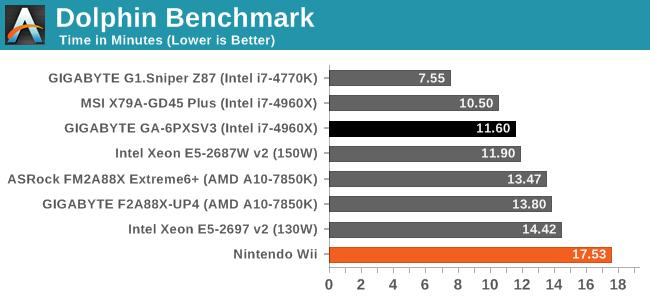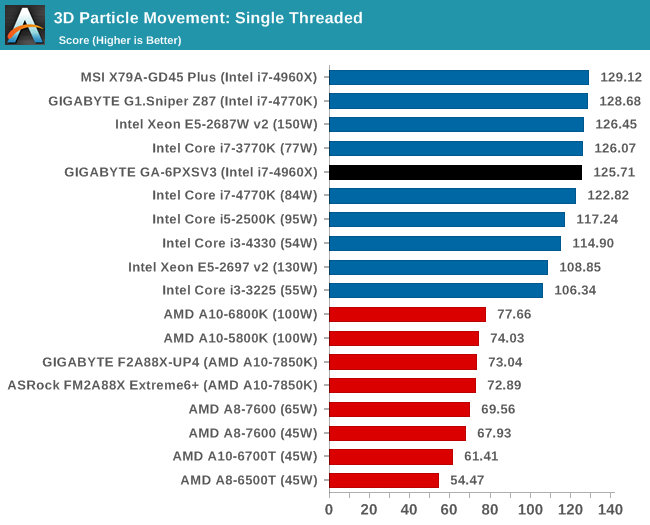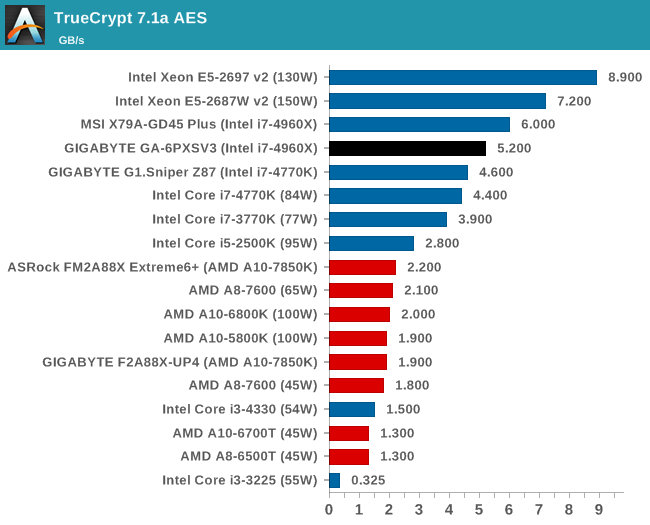GIGABYTE GA-6PXSV3 Review
by Ian Cutress on March 31, 2014 11:59 AM EST- Posted in
- Motherboards
- Gigabyte
- SLI
- CrossFire
- X79
- Enterprise
- C604
Scientific and Synthetic Benchmarks
2D to 3D Rendering –Agisoft PhotoScan v1.0: link
Agisoft Photoscan creates 3D models from 2D images, a process which is very computationally expensive. The algorithm is split into four distinct phases, and different phases of the model reconstruction require either fast memory, fast IPC, more cores, or even OpenCL compute devices to hand. Agisoft supplied us with a special version of the software to script the process, where we take 50 images of a stately home and convert it into a medium quality model. This benchmark typically takes around 15-20 minutes on a high end PC on the CPU alone, with GPUs reducing the time.

Using the slower memory of our server motherboard gives a small 5% decrease in our Agisoft test.
Console Emulation –Dolphin Benchmark: link
At the start of 2014 I was emailed with a link to a new emulation benchmark based on the Dolphin Emulator. The issue with emulators tends to be two-fold: game licensing and raw CPU power required for the emulation. As a result, many emulators are often bound by single thread CPU performance, and general reports tended to suggest that Haswell provided a significant post to emulator performance. This benchmark runs a Wii program that raytraces a complex 3D scene inside the Dolphin Wii emulator. Performance on this benchmark is a good proxy of the speed of Dolphin CPU emulation, which is an intensive single core task using most aspects of a CPU. Results are given in minutes, where the Wii itself scores 17.53; meaning that anything above this is faster than an actual Wii for processing Wii code, albeit emulated.

Point Calculations – 3D Movement Algorithm Test: link
3DPM is a self-penned benchmark, taking basic 3D movement algorithms used in Brownian Motion simulations and testing them for speed. High floating point performance, MHz and IPC wins in the single thread version, whereas the multithread version has to handle the threads and loves more cores.

Encryption –TrueCrypt v0.7.1a: link
TrueCrypt is an off the shelf open source encryption tool for files and folders. For our test we run the benchmark mode using a 1GB buffer and take the mean result from AES encryption.

Synthetic – 7-Zip 9.2: link
As an open source compression tool, 7-Zip is a popular tool for making sets of files easier to handle and transfer. The software offers up its own benchmark, to which we report the result.











12 Comments
View All Comments
mooninite - Monday, March 31, 2014 - link
I wouldn't recommend this board since it includes 82574L NICs that have known hardware errata that I have suffered myself. They are also quite old now (3+ years). Any new server board will include I350-based NICs and these seem to be rock solid in my testing.extide - Monday, March 31, 2014 - link
Odd that they left the remaining 8 PCIe lanes un-used. It would have been a better idea to route them to that last PCIe slot, instead of that slot using 2 lanes from the chipset.TeXWiller - Monday, March 31, 2014 - link
Do you have any experience with the i210 series? That seems to be the new value choice after the 82574L.Samus - Monday, March 31, 2014 - link
its funny you mention that, I had HP replace a motherboard in one of my clients Pro 4300 SFF workstations and the new board had an i210, the old board had a Broadcom, so it seems people are moving toward the i210 on the newest hardware revisions.mooninite - Tuesday, April 1, 2014 - link
i210 would be fine. Anything except 82574L...Ktracho - Monday, March 31, 2014 - link
Any chance of getting a screen shot of the BIOS screen for Advanced/PCI Subsystem Settings? We are very interested in a motherboard that supports the latest NVIDIA Tesla / Xeon Phi boards (which the GA-7PESH3 motherboard support), but we have not been able to find specific information about this Gigabyte motherboard. The key would be for the BIOS screen to have a setting for "PCI 64bit Resources Handling"/"Above 4G Decoding". Can you confirm if this setting exists for the GA-6PXSV3? ASUS has a competing motherboard with a similar setting in the BIOS, but it does not meet our requirements.Ian Cutress - Monday, March 31, 2014 - link
It's in the gallery, third picture along.http://www.anandtech.com/Gallery/Album/3508#3
yuhong - Tuesday, April 1, 2014 - link
"The GIGABYTE BIOS may not be UEFI"It is UEFI, notice the UEFI shell item.
BMNify - Tuesday, April 1, 2014 - link
"GIGABYTE Server GA-6PXSV3 we are reviewing today is aiming to supply enough at the lower end of the extreme workstation segment."its hard to pick the April fool news as this cant be considered "the lower end of the extreme workstation segment." at 349€95 http://www.ldlc.com/fiche/PB00140021.html surely, with only a single socket and not enough PCI-E slots to fill with a reasonable amount of fast PCI-E SSD's plus gfx cards....
toyotabedzrock - Tuesday, April 1, 2014 - link
I had a workstation board by supermicro in the slot 1 era of P2 and P3 and it's bios was very graphical and used a mouse. I don't understand why the bios interface went from that to an 80s era design and stayed there.